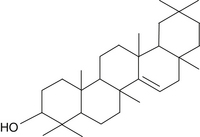Chapter 127 Taraxacum officinale (Dandelion)
Taraxacum officinale (family: Compositae)
• English: dandelion, wet-a-bed, lion’s tooth
• French: dent-de-lion, pissenlit
• German: Lowenzahn, Pfaffenrohrlein
• Chinese: p’u kung ying, Ching p’o po, chiang-nou-ts’ao, huang-hua-tii-ting
 General Description
General Description
Dandelion (Taraxacum officinale) is a member of the Compositae family and is closely related to chicory. Several origins have been attributed to the name Taraxacum, the most likely being from the Greek taraxo (“disorder,” “disturbance”), and akos (“remedy”), and akeomai (“I heal”) and from tharakhcharkon, possibly a derivative of a Persian-Arabic word for “edible” and the name by which the plant is referred to in a thirteenth-century Arabian botanical work.1
 Chemical Composition
Chemical Composition
Dandelion root’s calorie count is exceptionally low—a cup is only 25 calories—and its nutrient content is exceptionally high. In fact, dandelion root has greater nutritional value than many other vegetables. It is particularly high in vitamins and minerals, protein, choline, inulin, and pectin. Its carotenoid content is extremely high, as reflected by its having a higher vitamin A content (as beta-catotene) than carrots (dandelion has 14,000 IU of vitamin A per 100 grams, compared with 11,000 IU for carrots). Dandelion greens are an outstanding source of vitamin A and an excellent source of vitamin C, riboflavin, vitamin B6, and thiamine as well as calcium, copper, manganese, and iron.2
The primary therapeutic actions of dandelion are believed to be due to the bitter principle of taraxacin, various terpenoids, inulin, and its high concentration of nutrients, especially choline.3 Other constituents of dandelion that may contribute to its pharmacologic effects are resins, pectin, taraxanthin (a carotenoid pigment in the flowers), fatty acids, and flavonoids.
The roots of T. officinale contain the triterpenes b-amyrin, taraxasterol, and taraxerol and the sterols sitosterin, stigmasterin, and phytosterin (Figures 127-1 and 127-2).4
Later research has elicited several compounds that are likely to be clinically significant. Three flavonoid glycosides—luteolin 7-glucoside and two luteolin 7-diglucosides—have been isolated from dandelion flowers and leaves, together with free luteolin and chrysoeriol in the flower tissue. Three hydroxycinnamic acids—chicoric acid, monocaffeyltartaric acid, and chlorogenic acid—have been found throughout the plant, and the coumarins cichoriin and aesculin have been identified in leaf extracts. Chicoric acid and the related monocaffeyltartaric acid were found to be the major phenolic constituents in dandelion flowers, roots, leaves, and involucral bracts and also in the medicinal preparations tested.5





